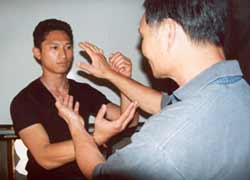|
 The First Structive Form is the Small Contemplation (Sil Nim Tao) Form. It is THE form in articulating the fundamental range and movement grid of the upper limbs while cultivating the unique G-Force. Grandmaster Tsui Seung-Tin, whose power is legendary in the Wing-Chun circle is an adept on this form. Anecdotal evidence suggested that the late Bruce Lee was so enamoured with this form that according to his friend Peter Tai, the late superstar would practise it more than three hundred times a day! That may also explain his incredible dexterity, velocity, placement, spontaneity and intelligence in hand technique executions. Below we cover briefly, some of the vital intricacies we believe are critical to harvesting the very best from the clever practice of this form. The First Structive Form is the Small Contemplation (Sil Nim Tao) Form. It is THE form in articulating the fundamental range and movement grid of the upper limbs while cultivating the unique G-Force. Grandmaster Tsui Seung-Tin, whose power is legendary in the Wing-Chun circle is an adept on this form. Anecdotal evidence suggested that the late Bruce Lee was so enamoured with this form that according to his friend Peter Tai, the late superstar would practise it more than three hundred times a day! That may also explain his incredible dexterity, velocity, placement, spontaneity and intelligence in hand technique executions. Below we cover briefly, some of the vital intricacies we believe are critical to harvesting the very best from the clever practice of this form.
Key Reference: (Wing-Chun Botin) by Tsui Seung-Tin. Incredibly valuable both as a reference and a working textbook. The English translation is still not published. Some sources close to Tsui, claim that Tsui is pound for pound one of the most powerful man on earth. Tsui, on a seminar tour in Holland in 1995, clearly demonstrated his immense power he could muster against exceptionally strong fighters. This is consistent with the principles of Wing-Chun Gungfu.
1. The basic constituents of the G-Force (not necessarily in any order) -
 1. Contra-polarisation Energetic - Yin-Yang Paradox; 1. Contra-polarisation Energetic - Yin-Yang Paradox;
2. Mass Integration with Great Nature;
3. Unification with the Tao;
4. Transformation of Spirit into Emptiness (marrow);
5. Transformation of Chi into Spirit (sinew);
6. Transformation of Essence into Chi (bone);
7. Practical Astral, Auric & Etheric Aspects;
8. Mindwill Projection;
9. Bodymind Integration &Alignment; and
10. Bone, skin, pore and hair programming.
2. The basic Constructs of the G-Force -
1. the Cone;
2. the Sphere;
3. the Cube; and
4. the Tetrahedron
3. The basic mobility and application of the G-Force -
1. the straight thrust; and
2. the Spin.
4. The Mindpower of the G-Force is the Mindwill.
1. The First Structive Form is composed of 8 sections -
1. The Beginning Cross Hands.
2. The Punch.
3. The Taan Sau Sequence.
4. The Palm Prints.
5. The Shield Hands.
6. The Arm Arcs.
7. The Flank Arms.
8. The Washing Arms Close. |